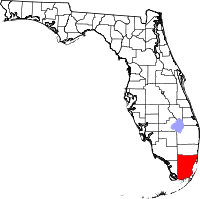Miami Beach, Florida
- See also: South Beach and North Beach (Miami Beach)
| City of Miami Beach | |||
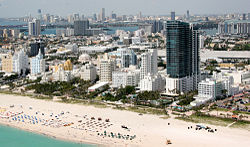 |
|||
|
|||
| Nickname(s): The Beach | |||
 |
|||
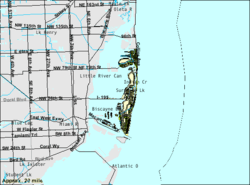 |
|||
| Coordinates: | |||
| Country | |||
|---|---|---|---|
| State | |||
| County | Miami-Dade | ||
| Incorporated | March 26, 1915 | ||
| Government | |||
| - Mayor | Matti Herrera Bower | ||
| Area | |||
| - City | 18.7 sq mi (48.5 km²) | ||
| - Land | 7.0 sq mi (18.2 km²) | ||
| - Water | 11.7 sq mi (30.2 km²) 62.37% | ||
| Elevation | 3 ft (1 m) | ||
| Population (2005) | |||
| - City | 87,925 | ||
| - Density | 12,502.1/sq mi (4,829.5/km²) | ||
| - Metro | 5,422,200 | ||
| Time zone | EST (UTC-5) | ||
| - Summer (DST) | EDT (UTC-4) | ||
| Zip | 33109, 33139, 33140, 33141. | ||
| Area code(s) | 305, 786 | ||
| FIPS code | 12-45025[1] | ||
| GNIS feature ID | 0286750[2] | ||
| Website: www.miamibeachfl.gov | |||
Miami Beach is a city in Miami-Dade County, Florida, United States. The city was incorporated on 26 March, 1915.[3] Miami Beach has been one of America's pre-eminent beach resorts for almost a century. The city is often referred to under the umbrella term of "Miami," despite being a distinct municipality, making Miami and Miami Beach two separate cities. As of the 2000 census, the city had a total population of 87,933. 55.5% of the population was foreign born.[4] A 2005 population estimate for the city was 87,925.[5]
Contents |
Description
In 1979 Miami Beach's Art Deco Historic District was listed on the National Register of Historic Places. The Art Deco District is the largest collection of Art Deco architecture in the world and comprises hundreds of hotels, apartments and other structures erected between 1923 and 1943. Mediterranean, Streamline Moderne and Art Deco are all represented in the District. The Historic District is bounded by the Atlantic Ocean on the East, Lenox Court on the West, 6th Street on the South and Dade Boulevard along the Collins Canal to the North. The movement to preserve the Art Deco District's architectural heritage was led by former interior designer Barbara Capitman, who now has a street in the District named in her honor.
Government
Miami Beach is governed by a Mayor and 6 Commissioners. The mayor runs commission meetings and the mayor and all commissioners have equal voting power. The Mayor serves for terms of 2 years with a term limit of 4 terms and commissioners serve for terms of 4 years and are limited to 2 terms. Commissioners are not voted for by region and every two years 3 commission seats are voted upon.
As of November 2007 the Mayor is Matti Herrera Bower. The Commissioners are: Saul Gross, Jerry Libbin, Richard Steinberg, Ed Tobin, Deede Weithorn and Jonah Wolfson.
Culture
Image and cultural depictions
South Beach (also known as SoBe, or simply The Beach the area from 1st street to about 25th street) is one of the more popular areas of Miami Beach. Topless sunbathing is tolerated on certain designated areas of the beach. Before the TV show Miami Vice helped make the area popular, SoBe was under urban blight, with vacant buildings and a high crime rate. Today, it is considered one of the richest commercial areas on the beach, yet poverty and crime still remain in some places near the area.[6]
Miami Beach, particularly Ocean Drive of what is now the Art Deco District, was also featured prominently in the 1983 feature film Scarface and the Birdcage.
The New World Symphony Orchestra is based in Miami Beach, Florida, under the direction of Michael Tilson Thomas.
Lincoln Road is a nationally known spot for great outdoor dining, bicycling, rollerblading and shopping.
Jewish population
The Miami Beach environs are home to a number of Orthodox Jewish communities with a network of well-established synagogues and yeshivas. It is also a magnet for Jewish families, retirees, and particularly snowbirds when the cold winter sets in to the north. They range from the Followers to the Modern Orthodox to the Haredi and Hasidic - including many rebbes who vacation there during the North American winter. There are a number of kosher restaurants and even kollels for post-graduate Talmudic scholars. Miami Beach had roughly 60,000 people in Jewish households, 62 percent of the total population, in 1982, but only 16,500, or 19 percent of the population, in 2004, said Ira Sheskin, a demographer at the University of Miami who conducts surveys once a decade.
Miami Beach is home to the Holocaust Memorial on Miami Beach.
Other
According to the Morgan Quitno Awards, Miami Beach is one of the most dangerous small cities (population between 75,000 and 99,999) in the country.[7]
Each December, The city plays host to the major contemporary art exhibition Art Basel Miami Beach.
Geography and climate



Miami Beach is located at (25.813025, -80.134065).[8]
According to the United States Census Bureau, the city has a total area of 48.5 km² (18.7 mi²). 18.2 km² (7.0 mi²) of it is land and 30.2 km² (11.7 mi²) of it (62.37%) is water.
It has a tropical climate.[9]
Surrounding areas
 Surfside
Surfside Atlantic Ocean
Atlantic Ocean Fisher Island
Fisher Island Biscayne Bay, Miami, North Bay Village
Biscayne Bay, Miami, North Bay Village
Demographics
As of the census[1] of 2000, there were 87,933 people, 46,194 households, and 18,339 families residing in the city. The population density was 4,829.5/km² (12,502.1/mi²). There were 59,723 housing units at an average density of 3,280.1/km² (8,491.2/mi²). The racial makeup of the city was 86.74% White (40.9% were Non-Hispanic Whites,)[10] 4.03% African American, 0.23% Native American, 1.37% Asian, 0.04% Pacific Islander, 4.05% from other races, and 3.53% from two or more races. Hispanic or Latino of any race were 53.45% of the population.
There were 46,194 households out of which 14.0% had children under the age of 18 living with them, 27.4% were married couples living together, 8.5% had a female householder with no husband present, and 60.3% were non-families. 48.7% of all households were made up of individuals and 14.8% had someone living alone who was sixty-five years of age or older. The average household size was 1.87 and the average family size was 2.76.
In the city the population was spread out with 13.4% under the age of 18, 7.8% from 18 to 24, 38.2% from 25 to 44, 21.3% from 45 to 64, and 19.2% who were sixty-five years of age or older. The median age was thirty-nine years. For every 100 females there were 105.0 males. For every 100 females age eighteen and over, there were 105.4 males.
The median income for a household in the city was $27,322, and the median income for a family was $33,440. Males had a median income of $33,964 versus $27,094 for females. The per capita income for the city was $27,853. About 17.0% of families and 21.8% of the population were below the poverty line, including 25.2% of those under age 18 and 24.5% of those age sixty-five or over.
As of 2000, speakers of Spanish as a first language accounted for 54.89% of residents, while English made up 32.75%, Portuguese was at 3.38%, French was at 1.66%, German at 1.12%, Italian 0.99%, and Russian was 0.85% of the population. Due to the large Jewish community, Yiddish made up 0.81% of speakers, and Hebrew was the mother tongue of 0.74% of the population.[11]
As of 2000, Miami Beach had the twenty-second highest percentage of Cuban residents in the US, with 20.51% of the populace.[12] It had the twenty-eighth highest percentage of Colombian residents in the US, at 4.4% of the city's population,[13] and the fourteenth highest percentage of Brazilian residents in the US, at 2.2% of the it's population (tied with Hillside, New Jersey and Hudson, Massachusetts.)[14] It also had the twenty-seventh most Peruvians in the US, at 1.85%,[15] while it had the twenty-seventh highest percentage of Venezuelans, at 1.79% of all residents.[16] Miami Beach's Honduran community had the thirty-third highest percentage of residents, which comprised 1.03% of the population.[17] It's also home to the forty-first highest percentage of Nicaraguan residents, which made up 1.03% of the population.[18]
Education
Miami-Dade County Public Schools serves Miami Beach.
- North Beach Elementary
- South Pointe Elementary
- Biscayne Elementary
- Fienberg/Fisher Elementary
- Nautilus Middle School (which is the only middle school for the Miami Beach area)
- Miami Beach Senior High School (which is the only high school for the Miami Beach area)
Tertiary education in Miami Beach includes a branch of the National School of Technology
Neighborhoods
- Bayshore
- Sunset Islands I & II
- Sunset Islands III & IV
- Sunset Harbour
- The Townhomes at Sunset Harbour
- Biscayne Point
- Stillwater Drive Neighborhood
- City Center
- Collins Park
- Fisher Island (A small portion of the island)
- Flamingo/Lummus
- Flamingo Park
- Flamingo Park West
- North Ocean Drive Area
- South Beach
- La Gorce
- Allison Island
- Aqua Allison Island
- La Gorce Island
- La Gorce Pine Tree
- Lower North Bay Road Neighborhood
- Middle North Bay Road Neighborhood
- Nautilus
- Alton Road Neighborhood
- Lakeview/Surprise Lake
- Orchard Park
- North Shore
- Little Buenos Aires
- Normandy Fountain
- Park View Island
- Normandy Isles
- Normandie Sud
- Normandy Shores
- Oceanfront
- South Pointe
- SoFi (South of Fifth)
- Star Island, Palm Island, & Hibiscus Island
- Venetian Islands, including Belle Isle
- Biscayne Island
- Di Lido Island
- Rivo Alto Island
- San Marco Island
- San Marino Island
- West Avenue/Bay Road
- Lincoln West
Points of interest
- Lincoln Road
- South Beach
- Holocaust Memorial
- Miami Beach Botanical Garden
- Flagler Monument Island
- Versace Mansion (Casa Casuarina)
- Wolfsonian-FIU Museum
- Ocean Drive
Sister Cities
- See also: List of sister cities in Florida
Miami Beach has 10 sister cities[19]
 Almonte, Spain
Almonte, Spain Ceský Krumlov, Czech Republic
Ceský Krumlov, Czech Republic Cozumel, Mexico
Cozumel, Mexico Fujisawa, Japan
Fujisawa, Japan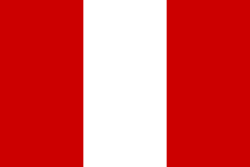 Ica, Peru
Ica, Peru Pescara, Italy
Pescara, Italy Nahariya, Israel
Nahariya, Israel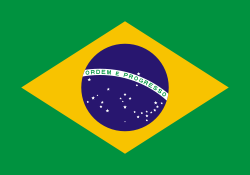 Fortaleza, Brazil
Fortaleza, Brazil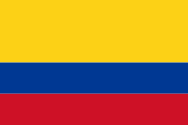 Santa Marta, Colombia
Santa Marta, Colombia Brampton, Canada[20]
Brampton, Canada[20]
See also
- List of upscale shopping districts
- South Florida
- Miami-Dade County
- Miami Beach Police Department
- Miami Modern Architecture
- John S. Collins
- Carl G. Fisher
- Collins Bridge
- Rosie the Elephant
- Fair Game (1996 film)
- Doral Hotel
- Ocean Drive
- Julia Tuttle Causeway
- Macarthur Causeway
- Venetian Causeway
- Spring Break
- 8th & Ocean
References
- ↑ 1.0 1.1 "American FactFinder". United States Census Bureau. Retrieved on 2008-01-31.
- ↑ "US Board on Geographic Names". United States Geological Survey (2007-10-25). Retrieved on 2008-01-31.
- ↑ Ruby Leach Carson. 40 Years of Miami Beach. pp. p.13.
- ↑ | FAIR: City Factsheet: Miami Beach, Florida
- ↑ http://www.census.gov/popest/cities/tables/SUB-EST2005-04-12.xls
- ↑ MSNBC: South Beach: Life imitates art, quite vicely www.msnbc.com
- ↑ City Crime Rankings by Population Group
- ↑ "US Gazetteer files: 2000 and 1990". United States Census Bureau (2005-05-03). Retrieved on 2008-01-31.
- ↑ Köppen Climate Map Aw=tropical
- ↑ "Demographics of Miami Beach, FL". MuniNetGuide.com. Retrieved on 2007-11-01.
- ↑ "MLA Data Center Results of Miami Beach, FL". Modern Language Association. Retrieved on 2007-11-01.
- ↑ "Ancestry Map of Cuban Communities". Epodunk.com. Retrieved on 2007-11-01.
- ↑ "Ancestry Map of Colombian Communities". Epodunk.com. Retrieved on 2007-11-01.
- ↑ "Ancestry Map of Brazilian Communities". Epodunk.com. Retrieved on 2007-11-01.
- ↑ "Ancestry Map of Peruvian Communities". Epodunk.com. Retrieved on 2007-11-01.
- ↑ "Ancestry Map of Venezuelan Communities". Epodunk.com. Retrieved on 2007-11-01.
- ↑ "Ancestry Map of Honduran Communities". Epodunk.com. Retrieved on 2007-11-01.
- ↑ "Ancestry Map of Nicaraguan Communities". Epodunk.com. Retrieved on 2007-11-01.
- ↑ Miami Beach Sister Cities Program
- ↑ "Historic Sister City Agreemtn Between Brampton and Miami Beach, Florida" (PDF), City of Brampton, Canada (2008-10-03). Retrieved on 2008-10-05.
Gallery
External links
Official sites
Photos
- The lifeguard towers of Miami Beach
- Photographs of Miami Beach From the State Library & Archives of Florida
Other
- Miami Beach: A History of an Ever-Changing City
- Miami Design Preservation League – Non-profit Organization for the preservation of Miami Beach Architectural History
- Environmental Coalition of Miami Beach - Non-profit Organization "Working towards a sustainable future for our community"
- Miami Beach, Florida is at coordinates
|
||||||||||||||||||||||||||
